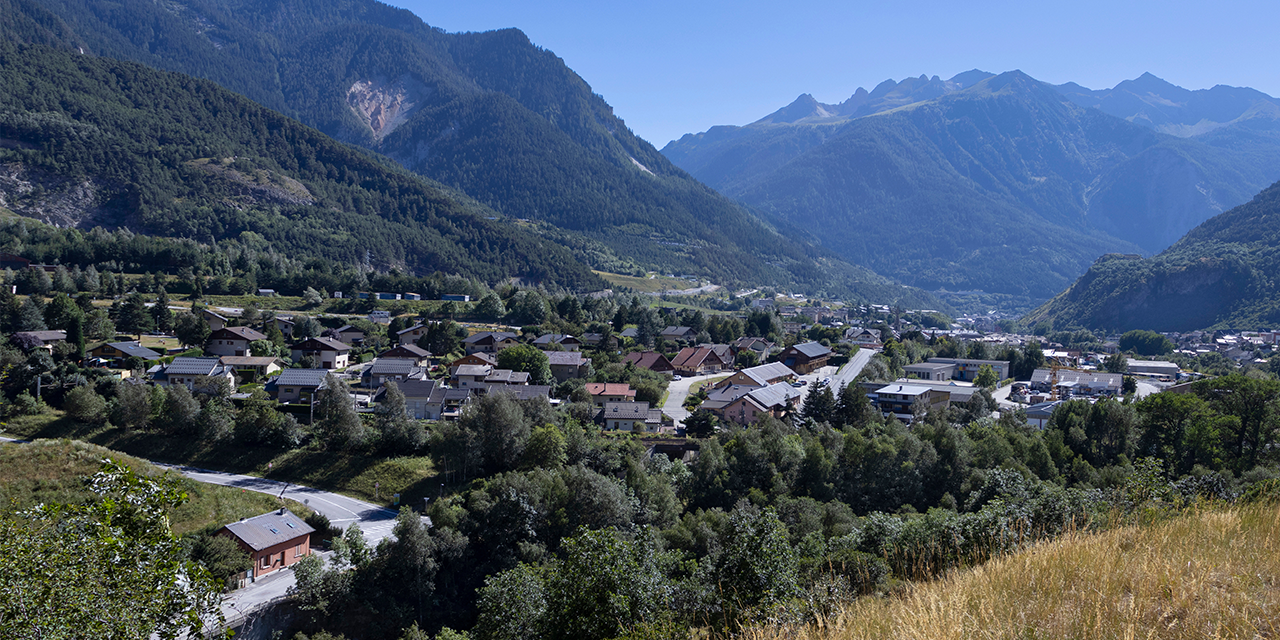
The research
While particle astrophysics is the principal focus for LSM, there is a long standing program to host other measurements from other scientific fields that can benefit from the extremely low cosmic-ray background of the LSM and the associated infrastructure for extremely low radioactivity experiments. The LSM has formal agreements for hosting germanium detectors of CNRS groups outside IN2P3 and of CEA, dedicated to environmental sciences. In addition, the LSM supports projects studying the impact of underground low radiation environments on biological systems. LSM also has and hosts multiple germanium detectors used to measure background radiation level in materials. An upgraded radon abatement system will be commissioned in the forthcoming future.
LSM is an unique underground laboratory, enabling a world-class science programme currently focused on neutrino and dark matter investigations but expanding to include a broader science base – and it is attracting internationally renowned scientists and experiments.
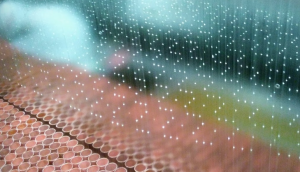 The SuperNEMO Demonstrator is undergoing its final integration and commissioning phase underground at LSM. The installation and commissionning of the active parts of SuperNEMO has started in November 2018. The installation of the shielding is currently underway. It builds on the success of the NEMO-3 (that completed its data taking in 2011) tracking-calorimetry technique, and aims to improve the sensitivity on the 0nBB (T1/2 > 6 × 1024 y with 6.3 kg of 82Se) thanks to a better background mitigation and event detection. Its scientific scope includes detailed studies of the 2nBB, single-state vs higher-state dominance discrimination, and the constraining of gA. The Demonstrator acts as a proof of principle of a full scale 100 kg multi-module detector, the sensitivity of which will scratch into the inverted hierarchy region.
The SuperNEMO Demonstrator is undergoing its final integration and commissioning phase underground at LSM. The installation and commissionning of the active parts of SuperNEMO has started in November 2018. The installation of the shielding is currently underway. It builds on the success of the NEMO-3 (that completed its data taking in 2011) tracking-calorimetry technique, and aims to improve the sensitivity on the 0nBB (T1/2 > 6 × 1024 y with 6.3 kg of 82Se) thanks to a better background mitigation and event detection. Its scientific scope includes detailed studies of the 2nBB, single-state vs higher-state dominance discrimination, and the constraining of gA. The Demonstrator acts as a proof of principle of a full scale 100 kg multi-module detector, the sensitivity of which will scratch into the inverted hierarchy region.
Collaboration website : https://supernemo.org/
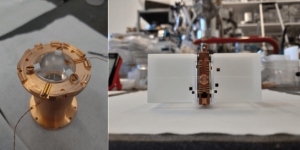 The BINGO project is funded in large part through an ERC (2020-2025). BINGO is a project aiming to set the grounds for large-scale bolometric neutrinoless double-beta-decay experiments capable of investigating the effective Majorana neutrino mass at a few meV level. It focuses on developing innovative technologies to achieve a very low background index, of the order of 10−5 counts/(keV kg yr) in the region of interest. The BINGO demonstrator, called MINI-BINGO, will be composed of Li2MoO4 and TeO2 crystals coupled to bolometric light detectors designed to investigate the promising double-beta-decay isotopes 100Mo and 130Te. This will allow us to reject a significant background in bolometers caused by surface contamination from α-active radionuclides by means of light yield selection. In addition, BINGO introduces new methods to mitigate other sources of background, such as surface radioactive contamination, external γ radioactivity, and pile-up due to random coincidence of background events.
The BINGO project is funded in large part through an ERC (2020-2025). BINGO is a project aiming to set the grounds for large-scale bolometric neutrinoless double-beta-decay experiments capable of investigating the effective Majorana neutrino mass at a few meV level. It focuses on developing innovative technologies to achieve a very low background index, of the order of 10−5 counts/(keV kg yr) in the region of interest. The BINGO demonstrator, called MINI-BINGO, will be composed of Li2MoO4 and TeO2 crystals coupled to bolometric light detectors designed to investigate the promising double-beta-decay isotopes 100Mo and 130Te. This will allow us to reject a significant background in bolometers caused by surface contamination from α-active radionuclides by means of light yield selection. In addition, BINGO introduces new methods to mitigate other sources of background, such as surface radioactive contamination, external γ radioactivity, and pile-up due to random coincidence of background events.
Collaboration website : http://www.bingo-neutrino.eu/
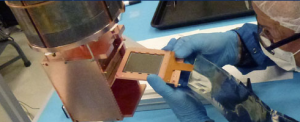 The DAMIC-M (DArk Matter In CCDs at Modane) experiment employs thick, fully depleted silicon charged-coupled devices (CCDs) to search for dark matter particles with a target exposure of 1 kg-year. It is funded in large part through an ERC (2018-2023) and by NSF. A novel skipper readout implemented in the CCDs provides single electron resolution through multiple non-destructive measurements of the individual pixel charge, pushing the detection threshold to the eV-scale. DAMIC-M will advance by several orders of magnitude the exploration of the dark matter particle hypothesis, in particular of candidates pertaining to the so-called "hidden sector." Indeed, DAMIC-M will search for low mass WIMPs (<5GeV/c2) through the nuclear recoil they would induce on silicon nuclei but will also probe much lighter candidate such as particles of the hidden sector through the electronic recoil they would provoke. DAMIC-M in its final stage will comprise 52 CCD modules for a total target mass of around 700 grams and a radioactive background goal of less than 1 event/keV/kg/day. It is going to be installed in the Modane Underground Laboratory in France in 2024. A prototype, the Low Background Chamber (LBC), with 20g of low background Skipper CCDs, has been successfully installed and commissioned in 2022 at LSM and is already giving world leading results in the search for leptophilic dark matter.
The DAMIC-M (DArk Matter In CCDs at Modane) experiment employs thick, fully depleted silicon charged-coupled devices (CCDs) to search for dark matter particles with a target exposure of 1 kg-year. It is funded in large part through an ERC (2018-2023) and by NSF. A novel skipper readout implemented in the CCDs provides single electron resolution through multiple non-destructive measurements of the individual pixel charge, pushing the detection threshold to the eV-scale. DAMIC-M will advance by several orders of magnitude the exploration of the dark matter particle hypothesis, in particular of candidates pertaining to the so-called "hidden sector." Indeed, DAMIC-M will search for low mass WIMPs (<5GeV/c2) through the nuclear recoil they would induce on silicon nuclei but will also probe much lighter candidate such as particles of the hidden sector through the electronic recoil they would provoke. DAMIC-M in its final stage will comprise 52 CCD modules for a total target mass of around 700 grams and a radioactive background goal of less than 1 event/keV/kg/day. It is going to be installed in the Modane Underground Laboratory in France in 2024. A prototype, the Low Background Chamber (LBC), with 20g of low background Skipper CCDs, has been successfully installed and commissioned in 2022 at LSM and is already giving world leading results in the search for leptophilic dark matter.
Collaboration website : https://damic.uchicago.edu/index.php
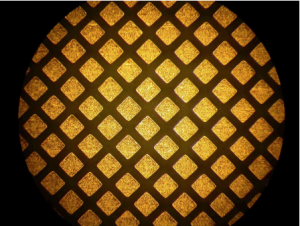 Directional Dark Matter Detection (DDM) can open a new signature for Weakly Massive Interacting Particles Dark Matter. The directional signature provides in addition, an unique way to overcome the neutron and neutrino backgrounds. In order to get the directional signature, the DDM detectors should be sensitive to low nuclear energy recoils in the keV range and have an angular resolution better than 20°.
Directional Dark Matter Detection (DDM) can open a new signature for Weakly Massive Interacting Particles Dark Matter. The directional signature provides in addition, an unique way to overcome the neutron and neutrino backgrounds. In order to get the directional signature, the DDM detectors should be sensitive to low nuclear energy recoils in the keV range and have an angular resolution better than 20°.
The MIMAC detector consists of a matrix of micro-Time Projection Chamber (TPC) developed in a collaboration between LPSC (Grenoble) and IRFU (Saclay). The detector first commissioning was performed at LSM in 2018 and the collaboration foreseen new test of an upgraded detector in 2025.
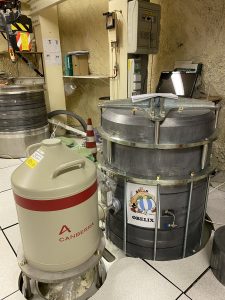 An Advanced Spectrometer to Study Rare Radioactive Processes
An Advanced Spectrometer to Study Rare Radioactive Processes
OBELIX spectrometer plays a key role in a unique experiment searching for double beta decay of the isotope 82Se to excited states of the daughter nucleus 82Kr. This process has never been detected before, and its detection could open a new direction in fundamental physics.
Present status and next steps: Over three years of continuous research, sensitivity was achieved at a level of T1/2 ∼ 4−5×1022 years. This is approximately three times higher than previously published limits for such measurements. During the measurements, the first statistically significant indicators of rare radioactive decay with a confidence level of ~3σ were found. This level is consistent with theoretical expectations. The additional detection of the double beta decay to excited states (in our case with 82Se) is important for further understanding of the structure of the atomic nucleus and rare nuclear processes. The OBELIX experiment shows that the sensitivity achieved allows us to study phenomena that were previously considered inaccessible.
The studies will be continued over the next 1-2 years with the aim of confirming the observed effect with high reliability (>4−5σ) or denying it. In parallel, preparations are underway for new experiments aimed at studying other rare radioactive processes.
International cooperation
OBELIX experiment is the result of an international collaboration that brings together leading research centers, including IEAP CTU, JINR, CNRS and INFN. This project confirms the status of the LSM laboratory as one of the world leaders in the study of rare physical phenomena.
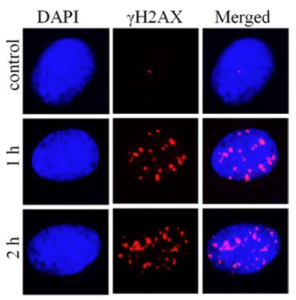 Studies of long-term cell culture storage in conditions of extremely low radiation background represent biological experiments in LSM. Normal human dermal fibroblasts are stored frozen in liquid nitrogen at - 196°C. Cell viability, level of apoptosis and changes of cell cycle are periodically evaluated for cell cultures stored as controls in normal laboratory conditions and at reduced radiation background in underground laboratory. Advanced characteristics of cell population are performed immediately upon cells thawing and after 24 hours incubation in normal cell culture media at 37°C. Level of DNA damage is assessed by immunoflurescent quantification of gamma-H2AX foci, which are sensitive molecular markers for DNA double-strand breaks.
Studies of long-term cell culture storage in conditions of extremely low radiation background represent biological experiments in LSM. Normal human dermal fibroblasts are stored frozen in liquid nitrogen at - 196°C. Cell viability, level of apoptosis and changes of cell cycle are periodically evaluated for cell cultures stored as controls in normal laboratory conditions and at reduced radiation background in underground laboratory. Advanced characteristics of cell population are performed immediately upon cells thawing and after 24 hours incubation in normal cell culture media at 37°C. Level of DNA damage is assessed by immunoflurescent quantification of gamma-H2AX foci, which are sensitive molecular markers for DNA double-strand breaks.
